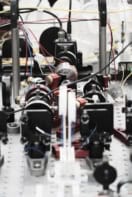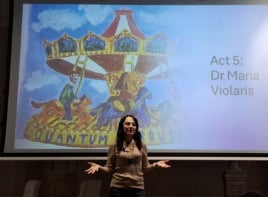Physicists have created “slow” and “fast” light in a crystal at room temperature for the first time. The team at the University of Rochester in the US used an ‘alexandrite’ crystal to reduce the speed of light to just 91 metres per second, and also to make a laser pulse travel faster than the speed of light. Previously these effects - which are not in conflict with special relativity - had only been observed at cryogenic temperatures or in complicated experimental set-ups. The new technique could be used for applications such as optical data storage, optical memories and quantum information devices (M Bigelow et al. 2003 Science 301 200).
Light travels at a speed of 300 million metres per second in a vacuum, but in recent years physicists have managed to slow laser pulses down to speeds of metres per second – or to bring them to a complete halt – in ultracold gases. In similar experiments physicists have observed superluminal or faster-than-light pulse propagation. These effects have also been observed in crystals at cryogenic temperatures and in “hot” gases. Now Matthew Bigelow, Nick Lepeshkin and Robert Boyd have observed the same effects in a much simpler system – a crystal at room temperature.
All the experiments exploit changes in the refractive index of an optical medium caused by quantum interference effects. Whereas previous experiments relied on a process known as “electromagnetically induced transparency”, the Rochester team exploited “coherent population oscillations” in the crystal. This involves shining two lasers – a pump beam and a weaker probe beam – at the crystal. Under certain conditions the probe beam experiences reduced absorption over a narrow range of wavelengths. The refractive index also increases rapidly in this “spectral hole”, which leads to a much reduced group velocity – the velocity at which a laser pulse travels – for the probe beam.
Earlier this year, the Rochester team used this technique to reduce the group velocity of a laser pulse to 58 metres per second in a ruby crystal at room temperature. Bigelow and co-workers have now repeated this feat in a crystal of alexandrite. Moreover, by using different wavelengths they can make a spectral “antihole” in which the absorption is higher, and which leads to superluminal propagation. They observed light speeds of 91 metres per second for a laser with a wavelength of 488 nanometres, and minus 800 metres per second for wavelengths of 476 nanometres. Negative speeds indicate superluminal velocities because the pulses appear to leave the crystal before they enter it under these conditions.
“Our technique is applicable to many solid materials, not just alexandrite,” Lepeshkin told PhysicsWeb. “Another important feature of our approach is the ability to cover a fairly broad range of optical frequencies.” The researchers will now investigate solid state materials with higher bandwidth to use in their system that are suitable for communication applications.


